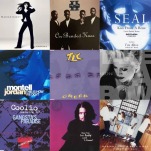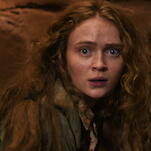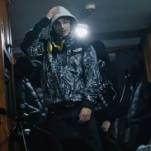Every two weeks, Big Issues focuses on a newly released comic book of significance. This week, it is Dark Nights: Metal #6. Written by Scott Snyder with art by Greg Capullo, Mikel Janin, and Raul Fernandez, inkers Jonathan Glapion and Alvaro Martinez, and colorists FCO Plascencia and June Chung, this issue wraps up a crossover event that delivered non-stop entertainment. This review reveals major plot points.
Superhero comics are often ridiculous, but that’s part of the fun. In a universe where anything can happen, why be serious when you can go way over-the-top? Dark Nights: Metal is a prime example of the joy of unbridled superhero spectacle, and the miniseries’ creators constantly challenge themselves to go bigger with every issue. Just take a look at the cover of the crossover’s final chapter. That’s Batman riding a dragon with the Joker’s face, flying away from a wall of fire with Superman and Wonder Woman at his side. It’s an image showcasing Metal’s emphasis on grandiose superhero fantasy, and the series is an exhilarating adventure through the DC Universe that builds on decades of continuity while still being fresh and invigorating.
Writer Scott Snyder and artist Greg Capullo’s Batman was the breakout hit of The New 52, so their reunion with inker Jonathan Glapion and colorist FCO Plascencia on Metal was a big deal when it was announced in April of last year. The “Superheavy” storyline was a highlight of their Batman run, toning down the horror elements to deliver a blockbuster action story that completely sold the idea of Jim Gordon as a mecha-Batman backed by the Gotham City Police Department. Metal carries the torch lit by “Superheavy” and turns it into an inferno that burns through the Multiverse, creating a thrilling crossover that actually lives up to the hype.
Batman is DC’s most profitable character, and Metal capitalizes on that fact by building an entire event around the Dark Knight and the idea that Batman always wins. The plot of Metal isn’t all that important. Magical metals (including one hilariously called “Batmanium”) open up a doorway to another dimension that unleashes a cosmic evil threatening to destroy all of existence, and there’s an evil Justice League made up of Batmen from different parts of the “Dark Multiverse.” You know, the typical superhero stuff. There still needs to be emotional stakes to make readers care about what’s happening, and in Metal, those come from Batman confronting his legacy and figuring out how to break free from a cycle of trauma that corrupts his soul with darkness.
Metal begins with the Justice League armored up and fighting in a gladiator ring for the entertainment of Mongul, facing off against robot versions of themselves built by The Toyman. The heroes eventually overtake those machines, and then they assemble them together Power Rangers-style into one supermech that they use to take out Mongul and escape. This opening sets the tone for the crossover, which is full of moments where you can feel the creators’ glee radiating off the page. Batman wields a baby Darkseid as a weapon, and when he’s pulled into the Dark Multiverse and attacked by evil versions of Superman, he puts on the “Five Finger Death Punch,” a riff on Marvel’s Infinity Gauntlet loaded up with every color of Kryptonite. Starro The Conqueror is reimagined with the speech patterns of a frat bro, Superman and Batman get a multiversal history lesson courtesy of The Sandman’s Daniel, and Hawkman is turned into a giant bird monster hammering away at the forge where universes are created.
This team strives to capture the exhilarating energy of heavy metal music and imagery in this series, and DC gave these creators the freedom to come up with some crazy shit. Metal’s conclusion is full of satisfying moments that keep turning up the volume, quite literally in the case of Wonder Woman banging Hawkman’s mace against her silver bracelets, creating a sonic boom that awakens her unconscious teammates. Plastic Man has been an egg for the entire series, a voluntary state of confinement because he gained his superpowers by being exposed to one of the mysterious dark metals, and in the finale, he breaks free and turns his body into a dinosaur, shark, octopus, buzzsaw, hammer, and baseball bat all at the same time. As Wonder Woman dives into the World Forge to rescue Batman and Superman, Detective Chimp shows up to help out the heroes on the surface, joined by a team of popular AU Batmen from books like The Dark Knight Returns, Batman & Dracula: Red Rain, Gotham By Gaslight, and Superman: Red Son.
This finale is a classic superhero showdown, but it also has some great twists like Batman and the Joker teaming up to take out The Man Who Laughs. Joker is armed with two Batarang switchblades, and this scene is a dramatic contrast to the dynamic Snyder created for these arch-nemeses in his Batman run. So much of Metal is about pulling the heroes into the depths of hopeless despair, but the resolution centers on banding together and finding strength in unity. Element X is the metal used in the World Forge, and it’s a part of everything. The heroes are able to stop Barbatos by tapping into the power at the core of each person in the universe, and this big action scene ends with a line that encapsulates the series’ grand message: “In the end, we’re all… a little metal.”
Greg Capullo was born to draw this series, and it allows him to deliver extravagant spectacle with a huge array of characters while still tapping into the horror skills he honed on books like Spawn and Batman. The first page of Metal #6 spotlights both of these visual elements, beginning with three creepy panels of The Man Who Laughs undoing the bandages of his prisoner before jumping to a monumental image of the supervillain Barbatos towering over Earth, surrounded by Joker-dragons. The following two-page spread has an outstanding shot of Wonder Woman swinging a mace with her golden lasso, and this issue reinforces Diana’s place as one of DC’s heavy-hitters.
The importance of Jonathan Glapion’s inking cannot be understated, and he significantly increases the level of detail and adds dimension to Capullo’s pencils. The characters fight against a smoky gray background, but colorist FCO Plascencia uses vibrant red, orange, purple, and green to make the action pop on the page. Blue is associated with hope in the DC Universe thanks to the Blue Lantern Corps, and Plascencia uses radiant shades of this color for the big climax of the issue, penetrating the darkness with the light of optimism.
The plot of Metal is a lot of fun, but the structure of the crossover is especially noteworthy. The complete story spans nearly 30 issues with tie-in one-shots and issues of ongoing series, but readers don’t have to read all of those in order to follow the central series. The two Dark Days books are required reading because they have important set-up information, but the “Dark Knights” one-shots are only necessary if readers want to learn the backstories of those evil Batmen.
The tie-in ongoing issues for Metal are very limited and solid reads. “Gotham Resistance” is a four-part story across Green Arrow, Nightwing, Suicide Squad, and Teen Titans taking those characters deep into a transformed Gotham City, and “Bats Out Of Hell” has The Flash, Hal Jordan And The Green Lantern Corps, and Justice League dealing with the seven Dark Knights. Unlike a crossover like Civil War II, the Metal tie-ins mostly span a single issue of these series, with the exception being two issues of Justice League. That’s how it should be, and rather than derailing a title for months on end, crossover tie-ins should get in and out quickly without forcing creators to put their larger plans on hold for an extended period of time.
Metal had its hiccups, specifically delays for the final three issues that forced DC to make sweeping changes to the publishing schedule of its “New Age Of Heroes” initiative, but ultimately the series was worth the wait. And DC was anticipating those delays, incorporating month-long breaks between the third and fourth issues and the fifth and sixth issues. Those off-months still had major Metal releases, and Batman: Lost and Dark Knights Rising: The Wild Hunt filled in story gaps and gave Snyder the opportunity to explore different aspects of this narrative with the help of co-writers. The Wild Hunt is an especially intriguing book, bringing Multiverse architect Grant Morrison on board for a story that builds on Morrison’s Multiversity and puts Detective Chimp in a key position for Metal’s finale.
Like any good crossover, Metal ends by setting the stage for the future of the DC Universe, bringing in artists Mikel Janin, Raul Fernandez, Alvaro Martinez, and June Chung for an epilogue that teases the upcoming “No Justice” storyline and the “New Age Of Heroes” books that have already begun. There are a lot of ideas presented in these pages, and DC has wisely given Snyder a lot of responsibility in carrying out these concepts, putting him at the head of “No Justice” and making him the writer of a relaunched Justice League series in June. That title will be joined by James Tynion IV and Raul Fernandez on a Wonder Woman-led Justice League Dark and Joshua Williamson and Stjepan Sejic on the cosmic-focused Justice League Odyssey, and after seeing how well these three writers collaborated on Metal and its tie-ins, there’s good reason to be excited for the future of the Justice League franchise.








































